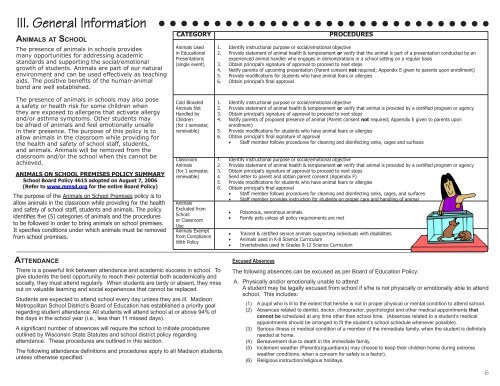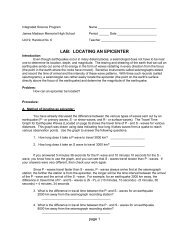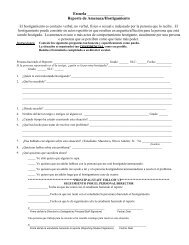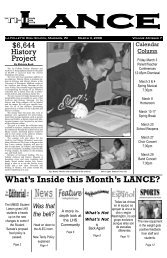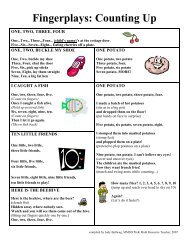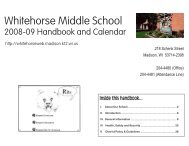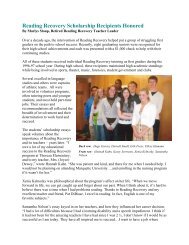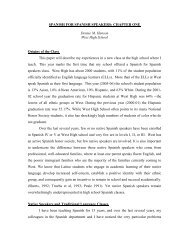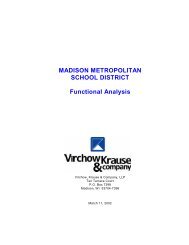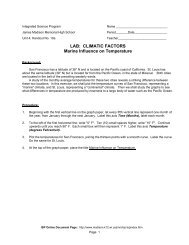Gompers Elementary School • 1502 Wyoming Way, Madison, WI ...
Gompers Elementary School • 1502 Wyoming Way, Madison, WI ...
Gompers Elementary School • 1502 Wyoming Way, Madison, WI ...
You also want an ePaper? Increase the reach of your titles
YUMPU automatically turns print PDFs into web optimized ePapers that Google loves.
III. General Information<br />
An im a l s at Sc h o o l<br />
The presence of animals in schools provides<br />
many opportunities for addressing academic<br />
standards and supporting the social/emotional<br />
growth of students. Animals are part of our natural<br />
environment and can be used effectively as teaching<br />
aids. The positive benefits of the human-animal<br />
bond are well established.<br />
The presence of animals in schools may also pose<br />
a safety or health risk for some children when<br />
they are exposed to allergens that activate allergy<br />
and/or asthma symptoms. Other students may<br />
be afraid of animals and feel emotionally unsafe<br />
in their presence. The purpose of this policy is to<br />
allow animals in the classroom while providing for<br />
the health and safety of school staff, students,<br />
and animals. Animals will be removed from the<br />
classroom and/or the school when this cannot be<br />
achieved.<br />
ANIMALS ON SCHOOL PREMISES POLICY SUMMARY<br />
<strong>School</strong> Board Policy 4615 adopted on August 7, 2006<br />
(Refer to www.mmsd.org for the entire Board Policy)<br />
The purpose of the Animals on <strong>School</strong> Premises policy is to<br />
allow animals in the classroom while providing for the health<br />
and safety of school staff, students and animals. The policy<br />
identifies five (5) categories of animals and the procedures<br />
to be followed in order to bring animals on school premises.<br />
It specifies conditions under which animals must be removed<br />
from school premises.<br />
CATEGORY<br />
Animals Used<br />
in Educational<br />
Presentations<br />
(single event)<br />
Cold Blooded<br />
Animals Not<br />
Handled by<br />
Children<br />
(for 1 semester,<br />
renewable)<br />
Classroom<br />
Animals<br />
(for 1 semester,<br />
renewable)<br />
Animals<br />
Excluded from<br />
<strong>School</strong><br />
or Classroom<br />
Use<br />
Animals Exempt<br />
from Compliance<br />
With Policy<br />
PROCEDURES<br />
1. Identify instructional purpose or social/emotional objective<br />
2. Provide statement of animal health & temperament or verify that the animal is part of a presentation conducted by an<br />
experienced animal handler who engages in demonstrations in a school setting on a regular basis<br />
3. Obtain principal’s signature of approval to proceed to next steps<br />
4. Notify parents of upcoming presentation (Parent consent not required; Appendix E given to parents upon enrollment)<br />
5. Provide modifications for students who have animal fears or allergies<br />
6. Obtain principal’s final approval<br />
1. Identify instructional purpose or social/emotional objective<br />
2. Provide statement of animal health & temperament or verify that animal is provided by a certified program or agency<br />
3. Obtain principal’s signature of approval to proceed to next steps<br />
4. Notify parents of proposed presence of animal (Parent consent not required; Appendix E given to parents upon<br />
enrollment)<br />
5. Provide modifications for students who have animal fears or allergies<br />
6. Obtain principal’s final signature of approval<br />
<strong>•</strong> Staff member follows procedures for cleaning and disinfecting sinks, cages and surfaces<br />
1. Identify instructional purpose or social/emotional objective<br />
2. Provide statement of animal health & temperament or verify that animal is provided by a certified program or agency<br />
3. Obtain principal’s signature of approval to proceed to next steps<br />
4. Send letter to parent and obtain parent consent (Appendix F)<br />
5. Provide modifications for students who have animal fears or allergies<br />
6. Obtain principal’s final approval<br />
<strong>•</strong> Staff member follows procedures for cleaning and disinfecting sinks, cages, and surfaces<br />
<strong>•</strong> Staff member provides instruction for students on proper care and handling of animal<br />
<strong>•</strong> Poisonous, venomous animals<br />
<strong>•</strong> Family pets unless all policy requirements are met<br />
<strong>•</strong> Trained & certified service animals supporting individuals with disabilities<br />
<strong>•</strong> Animals used in K-8 Science Curriculum<br />
<strong>•</strong> Invertebrates used in Grades 9-12 Science Curriculum<br />
At t e n d a n c e<br />
There is a powerful link between attendance and academic success in school. To<br />
give students the best opportunity to reach their potential both academically and<br />
socially, they must attend regularly. When students are tardy or absent, they miss<br />
out on valuable learning and social experiences that cannot be replaced.<br />
Students are expected to attend school every day unless they are ill. <strong>Madison</strong><br />
Metropolitan <strong>School</strong> District’s Board of Education has established a priority goal<br />
regarding student attendance: All students will attend school at or above 94% of<br />
the days in the school year (i.e., less than 11 missed days).<br />
A significant number of absences will require the school to initiate procedures<br />
outlined by Wisconsin State Statutes and school district policy regarding<br />
attendance. These procedures are outlined in this section.<br />
The following attendance definitions and procedures apply to all <strong>Madison</strong> students,<br />
unless otherwise specified.<br />
Excused Absences<br />
The following absences can be excused as per Board of Education Policy:<br />
A. Physically and/or emotionally unable to attend:<br />
A student may be legally excused from school if s/he is not physically or emotionally able to attend<br />
school. This includes:<br />
(1) A pupil who is ill to the extent that he/she is not in proper physical or mental condition to attend school.<br />
(2) Absences related to dentist, doctor, chiropractor, psychologist and other medical appointments that<br />
cannot be scheduled at any time other than school time. (Absences related to a student’s medical<br />
appointments should be arranged to fit the student’s school schedule whenever possible).<br />
(3) Serious illness or medical condition of a member of the immediate family, when the student is definitely<br />
needed at home.<br />
(4) Bereavement due to death in the immediate family.<br />
(5) Inclement weather (Parent(s)/guardian(s) may choose to keep their children home during extreme<br />
weather conditions, when a concern for safety is a factor).<br />
(6) Religious instruction/religious holidays.<br />
6


